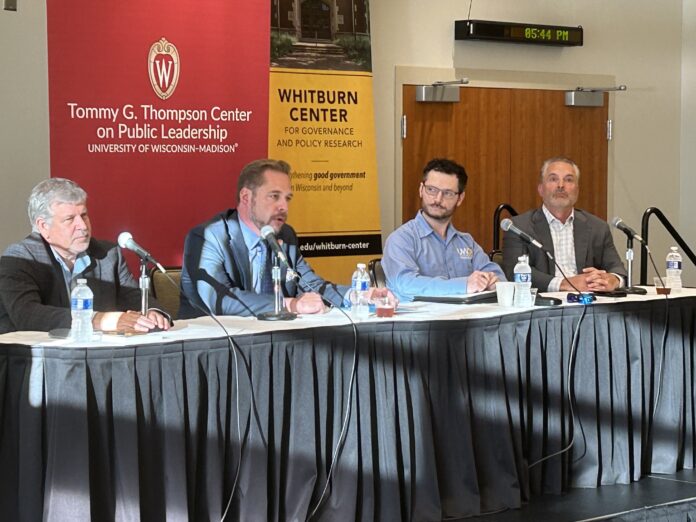A top engineer with Oshkosh Corporation says operators of electric vehicle fleets can save money on maintenance and other costs over time, helping to offset the significant upfront price tag.
Michael Moore, vice president of engineering at Oshkosh Corp., yesterday discussed the future of EVs in Wisconsin during a panel hosted by UW-Oshkosh, UW-Madison’s Tommy G. Thompson Center on Public Leadership and WisPolitics. It was held on the UW-Oshkosh campus.
According to Moore, an electric garbage truck can cost up to $800,000, compared to around $350,000 for a similar vehicle with an internal combustion engine. But he noted manufacturers can make adjustments to reduce the cost of operation over time, such as reducing the need for changing brakes, oil and filters.
Those changes, coupled with government incentives for the more environmentally friendly machines, can improve the financial picture in the long run, he said. For a garbage truck, which is typically operated over a 14-year period, the overall $2.5 million cost can be reduced by about 14 percent.
“Over a fleet that has 10,000 trucks in it, that’s a pretty significant payback for that operation,” Moore said.
Over the next four years, he said the company plans to spend about $300 million on electrification and another $200 million on autonomous vehicle technology. He noted those investments result in new products, additional jobs and economic growth in the state.
Meanwhile, a top state transportation official expects a legislative solution to charging ownership issues will arise soon as the electric vehicle transition takes hold in Wisconsin. DOT Assistant Deputy Secretary Joel Nilsestuen noted non-utility entities in the state can only charge a fee based on time spent charging.
“With the varying rates that cars accept electricity from the charger, there’s a degree of uncertainty, and so businesses need to be able to measure what they’re selling, so they can make their business decisions accordingly,” he said. “In Wisconsin our statutes currently don’t allow that.”
He explained any company selling electricity is considered a utility and is regulated as such, noting not every gas station owner wants to be regulated to the degree that utilities are. He said he’s optimistic that “in the near-term, that there will be a viable policy solution” to address this challenge moving through the Legislature.
Also during yesterday’s discussion, UW-Oshkosh Director of Parking and Transportation Ben Richardson said the university has seen rising interest in EV charging in recent years. Although the campus didn’t see much interest when chargers were first installed in 2012, he said, that’s changed over time.
“I think education is a big part of how we move forward with the revolution here, to help people understand how these vehicles work,” he said. “We still get questions … in the realm of range anxiety, where people are wondering, ‘How am I going to get from point A to point B?’”
Wisconsin has a plan for using the $78.65 million in federal dollars it will get over the next five years to deploy EV chargers around the state, Nilsestuen noted. Under this plan, 85 percent of people in Wisconsin will live within 25 miles of one of the 62 planned chargers, helping to reduce range concerns for EV owners.
“We have just under 14,000 registered electric vehicles in the state,” he said. “That may sound like a big number, but it really is about 2 percent of the state’s fleet at this point. The thing is, that’s growing very rapidly … about 9 percent each year from 2016 to 2020.”
Still, the current impact of that EV growth on the state’s energy grid is relatively minor, according to an executive with WEC Energy Group. But Dan Krueger, executive vice president of WEC’s infrastructure and generation planning division, said “concentrated need” for fast charging in a small area could mean more substations will be needed in the state.
“It’s all just a matter of coordination and planning, right? … We’re coordinated with the state on the corridor, all those stations, we have them mapped against our distribution system,” he said.
He also touched on a five-year, $50 million WEC pilot program for both residential and commercial customers, which helps offset the cost of installing EV charging stations. He said hundreds of chargers have already been installed through the program.
And though he noted a lot can change in the next five years, Krueger added “it’ll probably be decades before we see a huge transition.”
See more on the DOT plan here: https://wisconsindot.gov/Pages/projects/multimodal/electrification.aspx
Watch a video of the event here: https://www.youtube.com/watch?v=oPylwZZFOOg
–By Alex Moe






